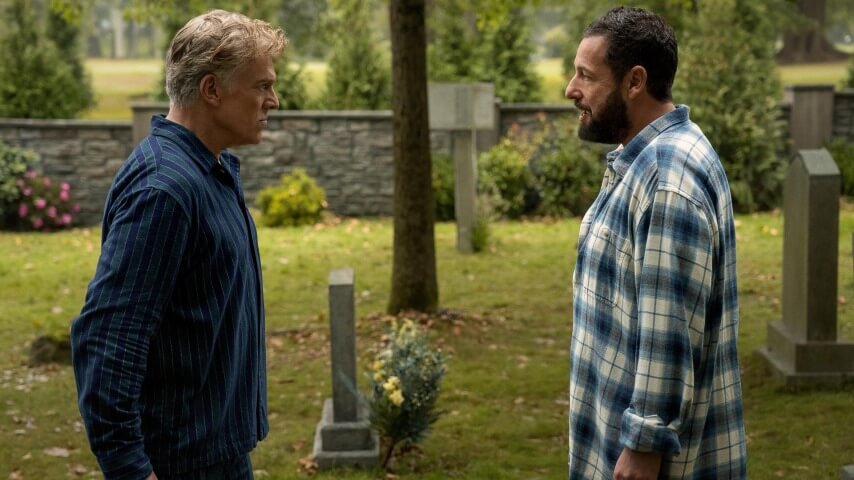Adam Sandler's at least shooting par with Happy Gilmore 2
The long-coming sequel to Sandler's slobs-versus-snobs golf comedy avoids the rough well enough.
Photo: Netflix
Happy Gilmore (Adam Sandler) is in the midst of a deep and lengthy depression. His beloved wife Virginia (Julie Bowen) has died, leaving him to care for five grown-ish children of indeterminate ages; he’s lost most of the money he made as a golf pro; and he’s turned to alcoholism to cope with his pain. Happy Gilmore 2 conveys that last bit with a running sight gag: Happy conceals his drinking through the use of disguised flasks, so periodically he’ll be using a TV remote or brandishing a cucumber at his supermarket job, unscrew a tiny cap, and reveal that the object in question actually contains alcohol as he enthusiastically chugs away.
It’s belabored to explain, and arguably just as belabored to witness as the movie reveals at least a dozen secret flasks over the course of the first 30 or 40 minutes. It is also a quintessential Adam Sandler gag: a little bit darkly transgressive; a little bit passive-aggressive; yet also whimsically silly and borderline simpleminded, in a way that makes it easy to imagine a 10-year-old pitching it. Then, furthering the latter sensibility, it is absolutely run into the ground. Yet in the grand tradition of strange comedy physics, some viewers may find themselves laughing at every dumb reveal—if not always at the joke itself, then maybe at the cheerful ridiculousness of the whole enterprise, the fact that Sandler and his longtime co-writer Tim Herlihy clearly found it even funnier. Sometimes a good mood brings a joke over.
This isn’t always the case with Sandler’s comedies. It isn’t even always the case with Happy Gilmore 2, which increases the 1996 golf comedy‘s runtime by 20 minutes seemingly through callbacks and golf-world cameos alone. Yes, in the years since Happy made the unlikely transition from brawling hockey player to rebel golfer, he has firmly planted himself within the golf establishment. But he’s also retired from the game, having literally lost his love for it: In the rich tradition of Sandler’s childlike approach to dark subjects, Virginia was killed by one of Happy’s errant golf shots. (This, too, is a callback of sorts, to the opening-credits death-by-hockey-puck of Happy’s father in the first film.) But when his only daughter Vienna (Sunny Sandler, naturally) shows enough promise to attend a prestigious but expensive dance school he can’t afford, Happy decides to give the sport another try.
The first Happy Gilmore remains one of Sandler’s better comedies because it provides him with a perfect framework for his cherished slobs-versus-snobs approach to comedy. The underdog sports stuff is as hoary as it comes, but without it, his movies can get real baggy, real fast—a bunch of slobs in search of snobs to identify and probably pants. Like the sequels to the ramshackle ’80s comedies that likely inspired the Sandman, Happy Gilmore 2 labors to get its hero back to the place where he began the first movie. Sandler and Herlihy deserve a little credit for grounding Happy’s reset in a genuine sense of sadness and loss. (It’s borderline shameless, but Sandler’s done worse in that department.) With a beardier face and a more gravelly voice, Sandler doesn’t particularly inhabit the old Happy Gilmore anymore—but then, as one of his characters conceived without a goofy vocal affectation, Happy’s defining characteristic was essentially Sandler’s youth, anyway. That and his foul temper, which this movie wisely redirects toward Happy’s frustrations with himself, so he doesn’t seem like a psychotic old man issuing beatdowns. When he does come to blows with his old nemesis Shooter McGavin (Christopher McDonald), it feels like an even match.
